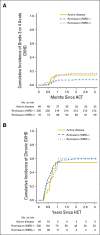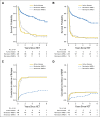Allogeneic Hematopoietic Cell Transplantation for Acute Myeloid Leukemia: Time to Move Toward a Minimal Residual Disease-Based Definition of Complete Remission?
- PMID: 26668349
- PMCID: PMC4872033
- DOI: 10.1200/JCO.2015.63.3826
Allogeneic Hematopoietic Cell Transplantation for Acute Myeloid Leukemia: Time to Move Toward a Minimal Residual Disease-Based Definition of Complete Remission?
Abstract
Purpose: Patients with acute myeloid leukemia (AML) who are in morphologic complete remission are typically considered separately from patients with active disease (ie, ≥ 5% marrow blasts by morphology) in treatment algorithms for allogeneic hematopoietic cell transplantation (HCT), which implies distinct outcomes for these two groups. It is well recognized that the presence of minimal residual disease (MRD) at the time of transplantation is associated with adverse post-HCT outcome for those patients in morphologic remission. This effect of pre-HCT MRD prompted us to compare outcomes in consecutive patients in MRD-positive remission with patients with active AML who underwent myeloablative allogeneic HCT at our institution.
Patients and methods: We retrospectively studied 359 consecutive adults with AML who underwent myeloablative allogeneic HCT from a peripheral blood or bone marrow donor between 2006 and 2014. Pre-HCT disease staging included 10-color multiparametric flow cytometry on bone marrow aspirates in all patients. Any level of residual disease was considered to be MRD positive.
Results: Three-year relapse estimates were 67% in 76 patients in MRD-positive morphologic remission and 65% in 48 patients with active AML compared with 22% in 235 patients in MRD-negative remission. Three-year overall survival estimates were 26%, 23%, and 73% in these three groups, respectively. After multivariable adjustment, MRD-negative remission status remained statistically significantly associated with longer overall and progression-free survival as well as lower risk of relapse compared with MRD-positive morphologic remission status or having active disease, with similar outcomes between the latter two groups.
Conclusion: The similarities in outcomes between patients in MRD-positive morphologic remission and those with active disease at the time of HCT support the use of treatment algorithms that use MRD- rather than morphology-based disease assessments.
© 2015 by American Society of Clinical Oncology.
Conflict of interest statement
Authors' disclosures of potential conflicts of interest are found in the article online at www.jco.org. Author contributions are found at the end of this article.
Figures




Comment in
-
Using Minimal Residual Disease to Improve Treatment Response Definitions and Hematopoietic Cell Transplantation Strategy in Acute Leukemia.J Clin Oncol. 2016 Feb 1;34(4):300-2. doi: 10.1200/JCO.2015.64.8907. Epub 2015 Dec 14. J Clin Oncol. 2016. PMID: 26668347 No abstract available.
-
When the Minimal Becomes Measurable.J Clin Oncol. 2016 Jul 20;34(21):2557-8. doi: 10.1200/JCO.2016.67.6395. Epub 2016 May 16. J Clin Oncol. 2016. PMID: 27185839 No abstract available.
-
Reply to C.S. Hourigan et al.J Clin Oncol. 2016 Jul 20;34(21):2558-9. doi: 10.1200/JCO.2016.67.6692. Epub 2016 May 16. J Clin Oncol. 2016. PMID: 27185840 No abstract available.
-
Reply to C.S. Hourigan et al.J Clin Oncol. 2016 Jul 20;34(21):2559-60. doi: 10.1200/JCO.2016.67.6700. Epub 2016 May 16. J Clin Oncol. 2016. PMID: 27185844 No abstract available.
References
-
- Gupta V, Tallman MS, Weisdorf DJ. Allogeneic hematopoietic cell transplantation for adults with acute myeloid leukemia: myths, controversies, and unknowns. Blood. 2011;117:2307–2318. - PubMed
-
- Hamilton BK, Copelan EA. Concise review: The role of hematopoietic stem cell transplantation in the treatment of acute myeloid leukemia. Stem Cells. 2012;30:1581–1586. - PubMed
-
- Cornelissen JJ, Gratwohl A, Schlenk RF, et al. The European LeukemiaNet AML Working Party consensus statement on allogeneic HSCT for patients with AML in remission: An integrated-risk adapted approach. Nat Rev Clin Oncol. 2012;9:579–590. - PubMed
-
- Vyas P, Appelbaum FR, Craddock C. Reprint of: Allogeneic hematopoietic cell transplantation for acute myeloid leukemia. Biol Blood Marrow Transplant. 2015;21:S3–S10. 2015 (suppl 2) - PubMed
Publication types
MeSH terms
Grants and funding
LinkOut - more resources
Full Text Sources
Other Literature Sources
Medical

